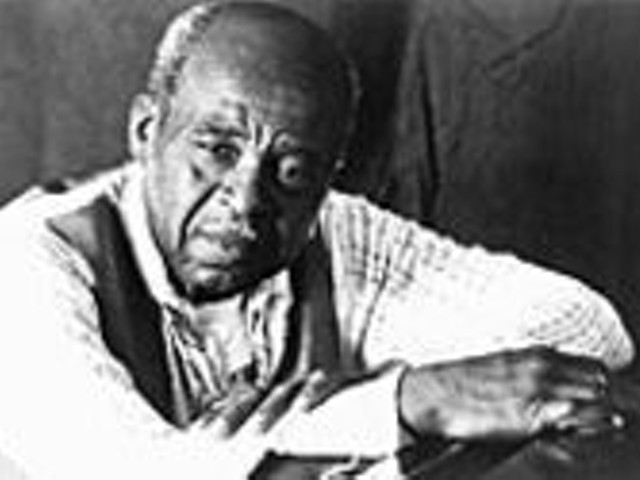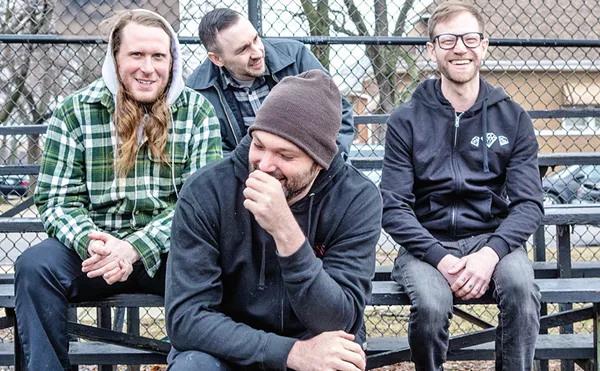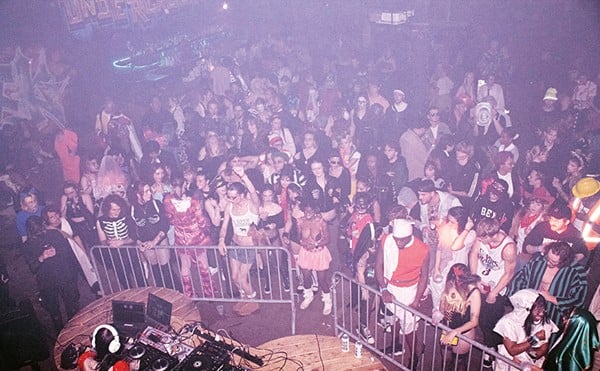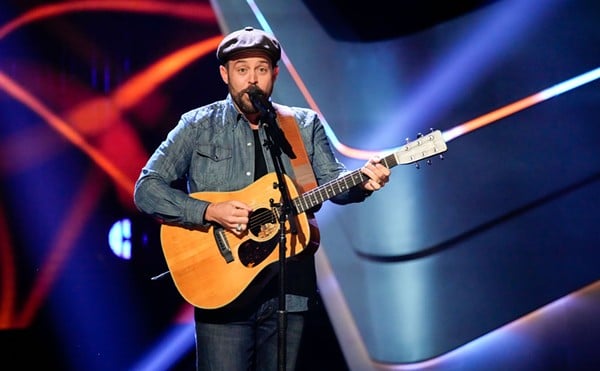It all seems unbelievable but for one concrete piece of incontrovertible evidence: Resurrection, the album recorded by the Aerovons in 1969 but issued for the first time only recently. Frank actually left the band just before the recording and plays only on one bonus track, but he's pictured all over the impressive liner notes. Even without his shaggy '60s mop, Frank is easily recognizable as the skinny kid with the big eyes in those grainy old eight-by-tens.
The Aerovons' story is surely the only rock & roll legend that begins It all started at Bayless High School.... That's where Frank met Tom Hartman, a musical prodigy one year Frank's junior who had recently moved to St. Louis from Miami with his family.
Frank was in a band called the Generation, but was disappointed by his mates' lack of musical training or ambition. When he saw Hartman onstage with an early Aerovons lineup in 1965, Frank was instantly impressed. "I go hear him play," Frank remembers, "and it's like, 'Man, this guy's great; I could learn so much from this guy. I'd love to be in a band with him.'"
Within a few months, Hartman agreed, recruiting Frank to join the embryonic Aerovons on rhythm guitar. The band hit the mid-'60s teen-club circuit, regaling venues such as the Bat Cave and Castaways with its Brit-fixated sound. "As soon as a new Beatles album came out," Frank says, "we'd rush our asses down to Famous-Barr, pick it up and pick it out. We'd sit there and just study every song. At that time, we weren't thinking originals. We wanted to be a damn good copy band."
The Aerovons might have remained as such were it not for Maurine Hartman, Tom's mother, who stepped in to manage the still-teenaged band's business and booking. In Frank's words, Maurine "wanted to be in showbiz, but she got married and had kids. So she was sort of living through Tom." Her hardball attitude and business savvy opened doors for the fresh-faced teens. "Mrs. Hartman dealt with all the business, then she would tell us all the details," Frank says. "She could be a bitch, so she was very good out in the business world. Suddenly we were playing a lot of good gigs.
"Some of them didn't make us money but got us talked about on the radio. She got us on this train that went from downtown St. Louis to Clarksville, Missouri. They called it the Last Train to Clarksville and had a band playing in each car of the train. Well, it was a huge failure because the electricity on there couldn't handle the bands. But we got noticed."
Under Maurine's direction, the band played up its Anglophilia even more. The CD sleeve of Resurrection shows priceless promo photos of the Aerovons in full-on Rubber Soul mode, emoting meaningfully from beneath prodigious Swinging London hairdos. Business cards and fliers proclaimed "The Band With That 'Smashing' English Sound." Maurine Hartman was also absolutely determined that no romantic entanglements would slow the rise of the Aerovons. "She was always pushing us to get rid of our girlfriends," Frank says. "Here we are, just discovering girls, and she'd tell us, 'All they're going to do is hurt you. Get rid of them.' Was she right? Of course she was."
By 1967, giddy with local success and naïve enthusiasm, the band members set out to record at Abbey Road. That being the case, Maurine Hartman advised them to start writing their own material. "We went and bought this reel-to-reel and quit playing out," Frank says. "All we did was start writing songs and recording."
In the liner notes of Resurrection, Tom Hartman says that a Capitol Records rep heard the Aerovons recording at Premier Studios in St. Louis and brought the band to London. Frank can't recall that particular detail but remembers virtually everything else about their February 1968 trip. Still in high school, the impressionable Aerovons did a week on the London rock-star circuit, mouths agape and hearts aflutter. "The second night we're there (in London), she gets us into this club called the Speakeasy," Frank recalls. "There's Paul McCartney, Diana Ross, Michael Caine. I'm still in high school, seventeen years old at that point, and we're standing in the same room with these people! Later that night, I'm in the bathroom taking a leak next to Paul McCartney!
"There was this little black guy running around the club in this big bolero hat. And Hartman and me are like, 'Who's this fucker think he is, Jimi Hendrix?'" Sure enough, it was. Later on, Hendrix got onstage, borrowed a guitar and wowed the pop elite with half an hour of feedback. "We'd never heard that before," Frank continues. "Now, anybody can do it, but back then? He just had the whole place totally silent and focused. Stuff that had never existed before was happening right in front of your eyes."
On a tour of EMI Studios at Abbey Road, the St. Louis teens interrupted Syd Barrett's Pink Floyd in Studio Three ("They were nice, but you could see it in their faces: Get the hell out") before moving on to the almighty Studio Two. For these Beatles-besotted youth, the moment was as inexpressibly transcendent as you might expect. And then it got better: George Harrison popped in. Frank and Hartman barraged him with questions about guitar minutiae.
"He didn't know any of the answers," Frank recalls. "We're at home buying our albums trying to figure out what guitar, what settings he's using, and he's like, 'I don't know, I just picked one up and used it.'"
A contract was signed with EMI/Parlophone, and the Aerovons were sent home to write more songs before returning to Abbey Road in March of 1969. "Buzz" wasn't a music-industry term yet, but the Aerovons had it; EMI execs were trembling with anticipation of the band's limitless future. But Frank wouldn't be around to see it. True to Maurine's warnings, he was led astray by "a girl" and his youthful impulses, and he quit the band. Further details are neither forthcoming nor necessary. The Aerovons marched onward, finishing Resurrection at Abbey Road in June 1969.
Resurrection reveals that Tom Hartman had a melodic facility and confidence far beyond his seventeen years. "World of You" is a haunting pop-psychedelic masterpiece, heavy with Gothic atmosphere and sophisticated harmonies. "Words from a Song" is a sweeter, almost traditional ballad, whereas "She's Not Dead" gets tricky with some jazzy chords and rhythmic changes on the chorus. Throughout, Hartman speaks with the Beatles' vocabulary, recycling guitar sounds and arrangement tricks from every era of the Fab Four's career. It might have gone the other way, too: A persistent rumor has it that "Say Georgia" and "Resurrection" were swiped by the Beatles for "Oh, Darling" and "Across the Universe," respectively. Frank insists that the rumor is true.
After the sessions, it all started falling apart. Phil Edholm, Frank's replacement on rhythm guitar, had already quit the band, complaining that his songs weren't given a chance. Upon returning to St. Louis, drummer Mike Lombardo discovered that his wife had been cheating on him and went into shock, disappearing for long stretches at a time. EMI, balking at the dicey line-up situation, dropped the Aerovons and canned the album. "World of You" was released as a single in September 1969 -- a melancholy postscript, not the herald of a new sensation.
If Frank ever agonized over his missed opportunity, he doesn't show it anymore. Later in life, he just missed another shot at rock stardom: After playing bass for Johnny Cougar (Mellencamp) for five years, Frank cut his hand in a fall in 1981, quitting right before the breakthrough American Fool. He's played a little music here and there since then but not as a career. (Tom Hartman, on the other hand, lives in Miami and composes incidental music for television commercials; the two remain friends to this day.)
Frank is married now and devotes most of his time and energy to his business, repairing dents in cars. He gives the impression of someone who's too busy to muse about what should have been. As is his right, though, Frank is also proud, summoning Venice Café pals over to see the Resurrection jacket photos. "Hey, take a look at this," he says. "This is that band of mine I was telling you about." The kid who went from Bayless Road to Abbey Road orders another beer and laughs gently at his own unbelievable past.





